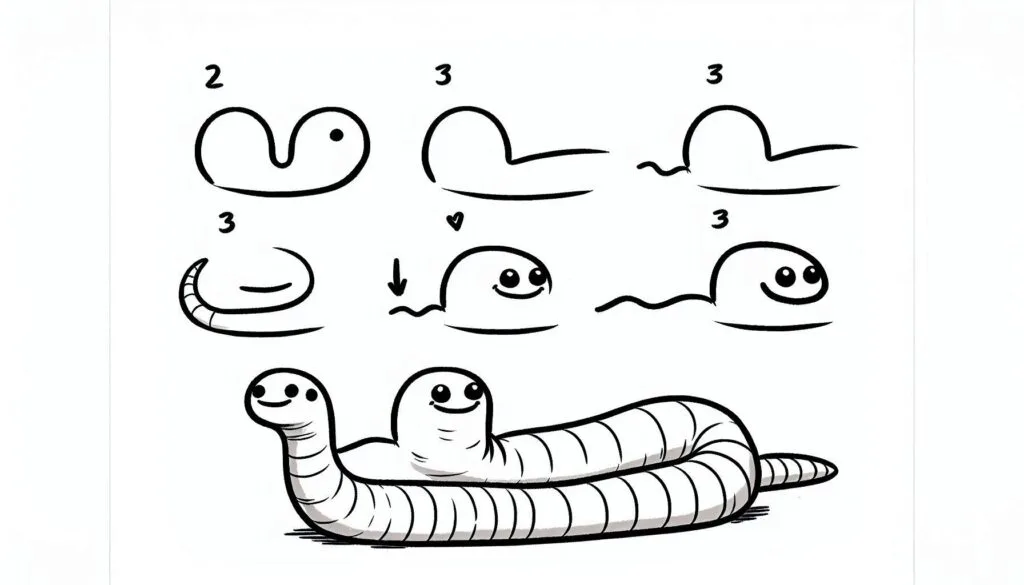Creating a caecilian drawing presents a one-of-a-kind and captivating artistic endeavor. These legless creatures, with their unique appearance and peculiar way of getting around, are truly captivating. In this guide, we’ll take you through the process of drawing a caecilian, paying close attention to its distinctive characteristics and incorporating artistic elements. Let’s embark on this imaginative journey and discover the mysteries of this subterranean creature!
The Fascinating Anatomy of Caecilians
Caecilians have elongated bodies that resemble worms and their skin is smooth and shiny. By familiarizing yourself with the anatomy of these little ones, such as their segmented appearance and distinctive characteristics, you’ll be able to create drawings that are both precise and captivating. By examining the caecilian’s structure, one can truly appreciate the distinctiveness of this captivating creature.
The Joy of Capturing Distinctive Characteristics
Creating a caecilian drawing requires capturing its sleek, cylindrical body and delicate textures. This can be an enjoyable and imaginative challenge, improving your drawing skills and your knack for portraying unique shapes. The better you are at capturing these features, the more realistic your caecilian drawing will appear.
Discovering the Fascinating World of Caecilians Through Art
Caecilians are fascinating amphibians that have developed remarkable adaptations to thrive in their underground habitat. Exploring the unique appearance and behavior of caecilians can be an interesting activity. This theme highlights the educational aspect of art and the opportunity to explore new aspects of amphibian life through creative expression.
Steps: How to Draw a Caecilian
First, start by sketching the fundamental outline.
Begin by sketching the fundamental outline of the caecilian’s body. Start with a lengthy, gently curved cylindrical form. Caecilians have sleek, elongated bodies, so be sure to capture their unique form. Create a design that showcases the body’s supple and adaptable characteristics by incorporating gentle curves.
Step 2: Now it’s time to add the head.
Place the head at one end of the cylindrical shape. The head of a caecilian has a gentle taper and rounded shape. Include a small, oval shape for the head and make sure it seamlessly merges with the body. Caecilians lack visible eyes on the surface, allowing you to either exclude them or include subtle indications if desired.
Step 3: Sketch the Segments
Caecilians display a segmented appearance, characterized by subtle rings or folds encircling their bodies. Create a sequence of subtle, curved lines that span the entire body to depict these sections. It is important to ensure that these lines are evenly spaced and flow with the contours of the body, resulting in a more organic appearance.
Step 4: Perfecting the Form
Consider using a darker writing utensil to carefully trace over your initial sketch and enhance the form of the caecilian. Refine the contours of the body and head. Make sure the sections are clearly defined and evenly distributed. Remove any unnecessary guidelines or overlapping lines to tidy up your drawing.
Step 5: Enhance the Texture
Caecilians have smooth skin with a subtle shine. To illustrate this texture, add some delicate shading and highlights along the body. Using light, smooth strokes can help capture the smooth, shiny surface of the skin. Consider adding subtle shading to the different sections of your drawing to create a sense of depth.
Step 6: Add some color to your caecilian.
Now it’s time to add some vibrant hues to your caecilian! Opt for shades of gray, brown, or black to represent the body, depending on the particular species you are illustrating. Caecilians typically have a consistent coloration with a subtle shine, so it’s important to maintain smooth and even colors. Consider incorporating subtle shading techniques to add depth and dimension to your artwork. Take note of the different areas of light and shadow in order to create a more lifelike caecilian drawing.
Topic 1: The Fascinating Structure of Caecilians
Exploring the anatomy of a caecilian through drawing allows you to appreciate its distinct features, such as its elongated, segmented body. Understanding these features enables you to create a comprehensive and precise representation. Understanding the intricacies of caecilian anatomy can greatly improve your artistic abilities and deepen your understanding of these captivating creatures.
Theme 2: Embracing the Joy of Capturing Distinctive Characteristics
The smooth, cylindrical body and subtle textures of a caecilian offer an engaging challenge for artists. Capturing these details requires creativity and skill, making it a great exercise for working with unique forms. Take pleasure in the process of bringing these distinct characteristics to life in your artwork.
Theme 3: Discovering the Fascinating World of Caecilians Through Art
Caecilians provide an opportunity to delve into lesser-known aspects of amphibian life, thanks to their unique appearance and underground habits. Exploring various textures and colors can add visual appeal and educational value to your artwork. This theme celebrates the excitement of exploring new dimensions of amphibian life through artistic expression.
In conclusion
Creating a caecilian drawing can be a fulfilling and captivating activity that enables you to depict the distinct characteristics and sleek texture of this intriguing amphibian. By following the steps in this guide and paying close attention to its anatomy, features, and colors, you can create a detailed and captivating caecilian drawing. Embrace the joy of artistic creation and let your imagination soar as you give form to this extraordinary subterranean creature on the canvas!


For a delightful and simple guide on how to draw an axolotl, you can find step-by-step instructions here. This fun tutorial provides easy steps, allowing young creators to dive into their imagination while discovering more about this captivating amphibian!





